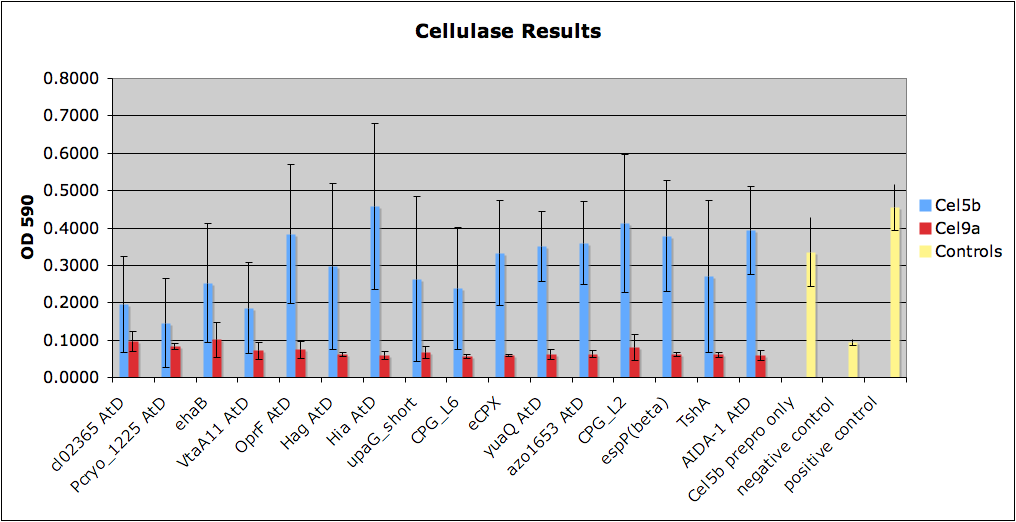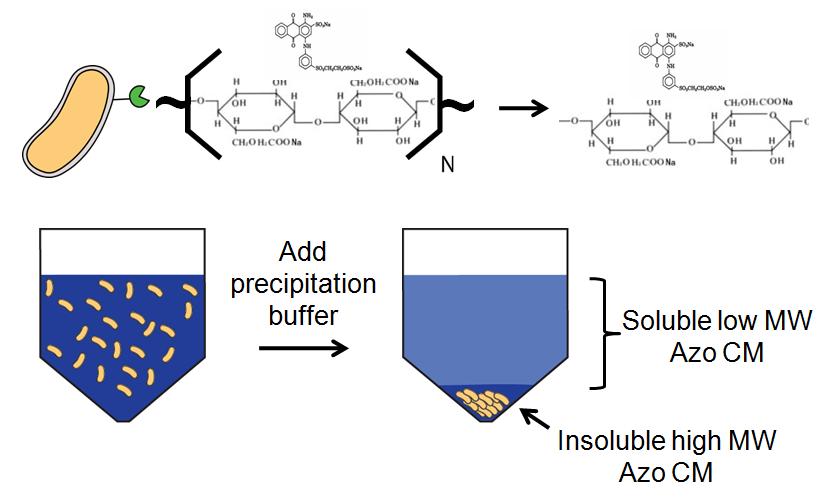Team:Berkeley Wetlab/Passenger: Cellulases
From 2009.igem.org
Jennbrophy (Talk | contribs) |
|||
| (23 intermediate revisions not shown) | |||
| Line 1: | Line 1: | ||
| - | + | {{newtemplateBerkeley}} | |
| - | + | __NOTOC__ | |
| - | == | + | ==Cellulases== |
| - | + | Cellulases are enzymes that catalyze the degradation of cellulose. Displaying cellulases on the cell surface allows the enzymes to act on insoluble cellulose present in the media that cannot diffuse into the cytoplasm. We made four cellulase display systems using cel9a, cel3a, cel5b, and cel6a from Celvibrio Japonicus. These cellulases contain cellulose binding domains which bind the enzyme to the cellulose substrate and are thought to disrupt the crystal structure of cellulose. Of the four cellulases, we were able to characterize the activity of the two endoglucanases, cel9a and cel5b. | |
| - | + | ||
| - | + | ||
==Functional Assay: Azo-CM-Cellulose== | ==Functional Assay: Azo-CM-Cellulose== | ||
'''This assay measures 1,4-Beta-D-endoglucanase activity using a soluble cellulose that has been dyed with Remazolbrilliant Blue''' | '''This assay measures 1,4-Beta-D-endoglucanase activity using a soluble cellulose that has been dyed with Remazolbrilliant Blue''' | ||
| - | [[ | + | [[Image:cellassay.jpg|600px|center]]<br> |
'''constructs:''' <br> | '''constructs:''' <br> | ||
| Line 26: | Line 24: | ||
====precipitate undegraded cellulose==== | ====precipitate undegraded cellulose==== | ||
| - | #Add 1mL Precipitation Buffer to each culture. | + | #Add 1mL [https://2009.igem.org/Team:Berkeley_Wetlab/Recipes#Precipitation_Buffer Precipitation Buffer] to each culture. |
#The high molecular weight fragments of cellulose will precipitate out leaving only the digested lower molecular weight fragments in solution | #The high molecular weight fragments of cellulose will precipitate out leaving only the digested lower molecular weight fragments in solution | ||
#Pellet for 10 minutes at 5400x. | #Pellet for 10 minutes at 5400x. | ||
#Take OD 590 measurements of 100uL of each sample. The higher the reading, the more blue digested fragments were present in the media and the stronger the endoglucanase activity. | #Take OD 590 measurements of 100uL of each sample. The higher the reading, the more blue digested fragments were present in the media and the stronger the endoglucanase activity. | ||
| - | |||
| - | |||
| - | |||
| - | |||
| - | |||
| - | |||
==Results== | ==Results== | ||
| + | ====Data==== | ||
| + | [[Image:cellulaseData.jpg|900px]]<br> | ||
| + | The high standard deviation is hypothesized to be due to unusual cell growth condition due to the dissolved Azo-CM-cellulose. Attempts to run the assay in lower concentrations of dissolved Azo-CM-cellulose (10 times dilution) gave no results for any construct including the positive control. | ||
| - | ==== | + | ====Conclusions==== |
| - | + | After running the assay, activity was observed for all cel5b constructs independent of the display system chosen. As this seemed to be an unusual result when compared to other passenger data, the assay was run again using a control of Cel5b with only the periplasmic targeting prepro sequence and no fused display system. It was found that Cel5b activity required only a prepro sequence and was not dependent upon the attached display system. | |
| - | + | ||
| - | + | ||
| - | + | ||
| - | + | ||
| - | + | ||
| - | + | ||
| - | + | ||
| - | + | ||
| - | + | ||
| - | + | ||
| - | + | ||
| - | + | ||
| - | + | ||
| - | + | ||
| - | + | ||
| - | + | ||
| - | + | ||
| - | + | ||
| - | + | ||
| - | + | ||
| - | + | ||
| - | + | ||
| - | + | ||
| - | + | ||
| - | + | ||
| - | + | ||
| - | + | ||
| - | + | ||
| - | + | ||
| - | + | ||
| - | + | ||
| - | + | ||
| - | + | ||
| - | + | ||
| - | + | ||
| - | + | ||
| - | + | ||
| - | + | ||
| - | + | ||
| - | + | ||
| - | + | ||
| - | + | ||
| - | + | ||
| - | + | ||
| - | + | ||
| - | + | ||
| - | + | ||
| - | + | ||
Latest revision as of 18:03, 21 October 2009
Cellulases
Cellulases are enzymes that catalyze the degradation of cellulose. Displaying cellulases on the cell surface allows the enzymes to act on insoluble cellulose present in the media that cannot diffuse into the cytoplasm. We made four cellulase display systems using cel9a, cel3a, cel5b, and cel6a from Celvibrio Japonicus. These cellulases contain cellulose binding domains which bind the enzyme to the cellulose substrate and are thought to disrupt the crystal structure of cellulose. Of the four cellulases, we were able to characterize the activity of the two endoglucanases, cel9a and cel5b.
Functional Assay: Azo-CM-Cellulose
This assay measures 1,4-Beta-D-endoglucanase activity using a soluble cellulose that has been dyed with Remazolbrilliant Blue
constructs:
Cel9a, an endoglucanase from Celvibrio japonicus (16)
Cel5b, an endoglucanase from Celvibrio japonicus (16)
Industrial cellulose degrading strain (14)
1363 negative control (1)
Cel5b, only prepro (1)
All experiments are done in triplicate
cell growth and induction
- inoculate cells from stock into LB with appropriate antibiotics and grow to saturation overnight (12+ hours)
- take OD 600 measurements of saturated culture to ensure approximately uniform cell densities.
- add 20uL of saturated culture to 0.5mL of LB containing 0.01g dissolved Azo-CM and 0.5 uL each of arabinose and the appropriate antibiotics
- allow cells to grow overnight
precipitate undegraded cellulose
- Add 1mL Precipitation Buffer to each culture.
- The high molecular weight fragments of cellulose will precipitate out leaving only the digested lower molecular weight fragments in solution
- Pellet for 10 minutes at 5400x.
- Take OD 590 measurements of 100uL of each sample. The higher the reading, the more blue digested fragments were present in the media and the stronger the endoglucanase activity.
Results
Data

The high standard deviation is hypothesized to be due to unusual cell growth condition due to the dissolved Azo-CM-cellulose. Attempts to run the assay in lower concentrations of dissolved Azo-CM-cellulose (10 times dilution) gave no results for any construct including the positive control.
Conclusions
After running the assay, activity was observed for all cel5b constructs independent of the display system chosen. As this seemed to be an unusual result when compared to other passenger data, the assay was run again using a control of Cel5b with only the periplasmic targeting prepro sequence and no fused display system. It was found that Cel5b activity required only a prepro sequence and was not dependent upon the attached display system.
 "
"







